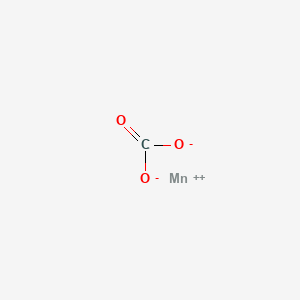



1. 598-62-9
2. Manganese(ii) Carbonate
3. Manganous Carbonate
4. Rhodochrosite
5. Manganese Carbonate (1:1)
6. Carbonic Acid, Manganese Salt
7. Manganese(2+) Carbonate
8. Manganese(2+);carbonate
9. Manganese Carbonate (mnco3)
10. 17375-37-0
11. Manganese(2+) Carbonate (1:1)
12. 9zv57512zm
13. Manganese(ii)carbonate
14. Carbonic Acid, Manganese(2+) Salt (1:1)
15. Natural Rhodochrosite
16. Mfcd00011116
17. Ccris 3660
18. Hsdb 790
19. Nsc-83512
20. Einecs 209-942-9
21. Nsc 83512
22. Unii-9zv57512zm
23. Einecs 241-414-3
24. Manganum Carbonicum
25. Ec 209-942-9
26. Rhodochrosite [inci]
27. Schembl32918
28. Dtxsid1042108
29. Manganese Carbonate [mi]
30. Manganese Carbonate [hsdb]
31. Manganum Carbonicum [hpus]
32. Carbonic Acid,manganese Salt
33. Manganese(ii) Carbonate, Mn 44%
34. Manganese Carbonate [who-dd]
35. Manganese(ii) Carbonate, Min. 90%
36. Akos015903237
37. Manganese(ii) Carbonate, P.a., 44%
38. Q414659
39. J-521674
40. Manganese(ii) Carbonate, 99.985% (metals Basis)
41. Manganese(ii) Carbonate, >=99.9% Trace Metals Basis
42. Manganese(ii) Carbonate Hydrate, 44-46% Mn Basis (kt)
43. 11-((5-dimethylaminonaphthalene-1-sulfonyl) Amino)undecanoic
| Molecular Weight | 114.947 g/mol |
|---|---|
| Molecular Formula | CMnO3 |
| Hydrogen Bond Donor Count | 0 |
| Hydrogen Bond Acceptor Count | 3 |
| Rotatable Bond Count | 0 |
| Exact Mass | 114.922787 g/mol |
| Monoisotopic Mass | 114.922787 g/mol |
| Topological Polar Surface Area | 63.2 Ų |
| Heavy Atom Count | 5 |
| Formal Charge | 0 |
| Complexity | 18.8 |
| Isotope Atom Count | 0 |
| Defined Atom Stereocenter Count | 0 |
| Undefined Atom Stereocenter Count | 0 |
| Defined Bond Stereocenter Count | 0 |
| Undefined Bond Stereocenter Count | 0 |
| Covalently Bonded Unit Count | 2 |
MANGANESE CARBONATE IS USED IN MEDICINE AS A HEMATINIC
Venugopal, B. and T.D. Luckey. Metal Toxicity in Mammals, 2. New York: Plenum Press, 1978., p. 263
The subcellular distribution of manganese (Mn) in brains of mice chronically admin Mn in different chemical forms with food was examined using gel chromatography. Male ddY-mice were divided into five groups of six animals each, & Groups 1 to 4 were given 2 grams/kilogram Mn of standard laboratory mouse chow) in the form of manganese chloride (MnCl2), manganese acetate (MnAc), manganese carbonate (MnCO3), or manganese oxide (MnO2), in the diets for 12 months, while Group 5 served as control. 24 hr after the last feed, animals were decapitated & brains were rapidly removed for study of the different regions (corpus striatum (CS), hypothalamus, midbrain, cerebral cortex (CC), hippocampus, cerebellum, & medulla oblongata). Subcellular fractions (mitochondrial, microsomal & cytosolic) & gel chromatography fractions were analyzed for Mn contents using flame atomizer absorption spectrophotometry. Results showed that CC levels of Mn in mice exposed to the nearly insoluble MnCO3 & MnO2 were higher than in controls, while Mn concns in the CS were similar to those in controls. Microsomal Mn in treated mice was also higher than in controls. The gel chromatographic profile of CS showed that 20% Mn was in the high molecular weight (MW) fractions, 45% was in the middle MW fractions, while 32% was in the low MW fractions. The % Mn in high MW fractions was higher (29% to 49%) in the Mn treated groups, than in controls. The % of Mn in low MW fractions of the MnO2 exposed group (9%) was lower than in the MnCl2, MnAc, & MnCO3 exposed groups (42%, 36%, & 38%, respectively). The authors conclude that the brain regional distribution of Mn from the virtually insoluble cmpds is different from that of soluble Mn cmpds, & that striatal subcellular & gel chromatographic profiles are similar for the divalent Mn cmpds. They add that there is more Mn associated with fast migrating ligands in the striatal cytosol of the Mn treated groups than in the controls, & that these binding characteristics are different from those of other organs.
PMID:8475509 Komura J et al.; Toxicology Letters 66 (3): 287-294 (1993)